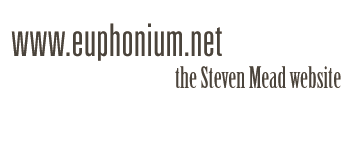Vibrato
One of the most debated topics in brass pedagogy around the world is the subject of vibrato. Not only is there the question of 'orchestral' versus 'brass band' vibrato (it's usage of course, rather the mechanics of how it is produced) but also nationalistic preferences which influence the application of vibrato. I hate to the use the word application as it sounds like adding something unnaturally, like make up on a lady, or plaster on brick work. These two interesting analogies can immediately reveal the dilemma for teachers and players. Vibrato cannot make some ugly become pretty but it can disguise some of its faults!! Tone and vibrato should never be confused. Over the years the expressive singing quality of players within the brass band movement has often been ridiculed by those outside, particularly from those within the hallowed institutions of music conservatories whose sole role in life seemed to be to prepare students a for life inside a symphony orchestra where straight tone was the expected norm for 99% of the time. When we listen to early brass band recordings from yesteryear we can hear how tastes in vibrato have changed; the cornet sound from the 1930s,40s and 50s is different than what we normally hear nowadays. The same of course can be said for euphonium players and many of my archive recordings, although incredibly important in the history of our instrument showcase examples of vibrato that would be considered 'old fashioned' now. It is not to demean the wonderful artists who have gone before but to point out there are clearly trends in vibrato that have changed over the years. The same of course is true when we listen to the great voices of the past such as Mario Lanza or Enrico Caruso whose vibrato was wider and faster than most voices we encounter today.
Today's brass band players may have to play music from Messers Sparke, Wilby, Ball, Vinter and in some cases more contemporary composers such as Pickard , Aagaard Nilsen et al in the same concert. The dilemma we have is, at the top level, whether to vary the vibrato at all for the different repertoire. You and I have probably heard some of our top bands soloists colour their sound in exactly the same way irrespective of the music's style or expressive content. This cannot be right and can lead us to secretly agree with some of the age-old criticism of 'bander's vibrato', where the blanket use of it can flatten stylistic differences and cancel out truly expressive playing where vibrato colouring can be such a potent communicative tool. It has also been said many bands' use of vibrato is deliberated designed to appeal to ageing judges in the box. This is a subject that can be picked up elsewhere but to return to the principal theme of this article, the use of vibrato in the brass band can be a wonderful means to be expressive , lyrical and passionate with our music. The use of varied vibrati, particularly with jazz and big band styles (once we sort out the right articulations, another separate topic!) can also make band's stylistic playing more convincing.
The use of vibrato for low brass instrument creates further distinctions between solo playing and section playing, but less so than for example in a wind band where the use of vibrato in brass instruments seems much more reserved for solo lines (and lyrical ones at that). Just how much more vibrato should a euphonium use than an Eb bass or a Bb bass? As a general rule, the lower the pitch the less alteration of the pitch (I hereby redefine vibrato, temporarily!) and the need for a stable harmonic underpinning of the harmony is required, but should a Bb bass player have a solo marked 'dolce molto cantabile' we could expect even this gentle giant of an instrument to 'sing'.
When used sensitively it puts the human element of warmth, beauty as well as the creation and resolution of tension into our music. For many vibrato is something that just happens, and for others it just doesn't happen!
If you are unsure of the mechanics of vibrato 'creation' for euph/baritone pitch and lower here is a quick five-step guide to the use of jaw vibrato
- Repeat over the word 'Yah' (like in a German women's institute meeting),yah yah yah yah
- Repeat again but silence the voice so only the jaw action continues
- Repeat again but try to keep the lips as fixed as possible so the movement is seemingly at the back of the jaw
- Repeat step three but simultaneously exhale strongly a strong stream on air with the lips in the 'playing' position with the jaw creating the messaging effect which is the basis of a rich and controlled vibrato
- Take up instrument and play some mid range long tones using the experience of step 4 to guide you.
Then listen and keep listening and refine your sound in the way an artist or sculptor will perfect a work of art. Listen to great singers, be it from the pop world, Broadway shows or opera. We have so many possibilities to assimilate sounds from them as well as great violinists and cellists. But in reality how many brass band players learn this way ? Is our musical world so different ? I leave you with questions!

